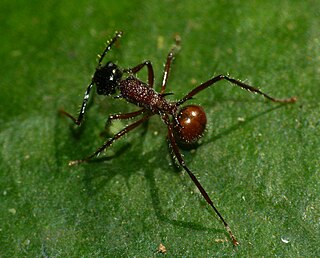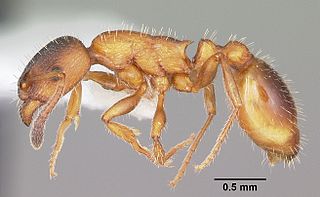
Myrmecophilus or ant crickets, is a genus of orthopteran insects in the family Myrmecophilidae. This genus contains the majority of myrmecophilous (ant-loving) species in this small, obscure family.

Myrmica is a genus of ants within the subfamily Myrmicinae. It is widespread throughout the temperate regions of the Holarctic and high mountains in Southeast Asia.

Oophagy or ovophagy, literally "egg eating", is the practice of embryos feeding on eggs produced by the ovary while still inside the mother's uterus. The word oophagy is formed from the classical Greek ᾠόν and classical Greek φᾱγεῖν. In contrast, adelphophagy is the cannibalism of a multi-celled embryo.
Leptothorax pocahontas is a threatened species of ant endemic to Alberta, Canada, facing a high risk of extinction.

The gyne is the primary reproductive female caste of social insects. Gynes are those destined to become queens, whereas female workers are typically barren and cannot become queens. Having a queen is what makes a "queenright" hive, nest, or colony of eusocial insects. A colony with multiple queens is said to be a polygyne form, whereas one with only one is a monogyne form.

Cardiocondyla is an Old World genus of ants in the subfamily Myrmicinae.

Formicoxenus is a genus of ants in the subfamily Myrmicinae.

Harpagoxenus sublaevis is a species of ant in the subfamily Myrmicinae. It is found in Austria, France, Germany, Italy, and Switzerland.

Myrmoxenus is a genus of ants in the subfamily Myrmicinae. The genus was synonymized under Temnothorax by Ward et al. (2015), but the change was not accepted by Heinze et al. (2015) due to insufficient available data.

Tetramorium inquilinum is an ectoparasitic ant found in Europe. It was discovered by Swiss myrmecologist Heinrich Kutter. The species is unusual for lacking a worker caste, the queens and males living entirely off the care of the pavement ant. It has been called "the 'ultimate' parasitic ant" by myrmecologists Edward O. Wilson and Bert Hölldobler.

Crematogastrini is a tribe of myrmicine ants with 64 genera and 8 fossil genera.

Romblonella is a genus of myrmicine ants.

Polyrhachis is a genus of formicine ants found in the Old World with over 600 species. The genus is yet to be comprehensively resolved and contains many varied species including nest-weavers, swimming workers, soil and tree-dwellers. First fossil record of this genus was P. annosa from Miocene.

Leptothorax acervorum is a small brown to yellow ant in the subfamily Myrmicinae. It was first described by Johan Christian Fabricius in 1793. L. acervorum is vastly distributed across the globe, most commonly found in the coniferous forests of Central, Western and Northern Europe. The morphology of L. acervorum is extremely similar to that of other Leptothorax ants. The difference arises in the two-toned appearance of L. acervorum, with the head and metasoma being darker than the mesosoma segment of the body, and hair across its body. Following Bergmann's rule—unusually, for ectothermic animals—body size increases with latitude.

Temnothorax is a genus of ants in the subfamily Myrmicinae. It contains more than 380 species.

Rotastruma is a small genus of arboreal ants in the subfamily Myrmicinae. Its two species are known from the Oriental region: the type species Rotastruma recava is known from the Bukit Timah Nature Reserve, Singapore, and Rotastruma stenoceps is known from Guangdong, China.

Slave-making ants or slaver ants are brood parasites that capture broods of other ant species to increase the worker force of their colony. After emerging in the slave-maker nest, slave workers work as if they were in their own colony, while parasite workers only concentrate on replenishing the labor force from neighboring host nests, a process called slave raiding.

Leptothorax muscorum is a species of ant of the genus Leptothorax that ranges through a variety of habitats throughout much of Europe, northern Asia, and North and Central America, with a particularly wide distribution in the palearctic. Capable of surviving in extreme Arctic-Alpine conditions, the species is perhaps the northernmost dwelling ant indigenous to the Western Hemisphere.

Temnothorax corsicus is a socially parasitic ant species known from Southern Europe, more specifically from Italy, France and Croatia. It is a workerless social parasite of the ant Temnothorax exilis in the same genus. It is most closely related to Temnothorax adlerzi, a species from Greece with a very similar life cycle.


















